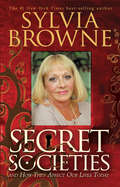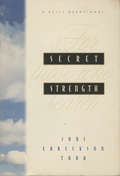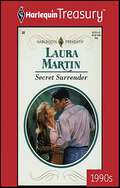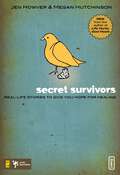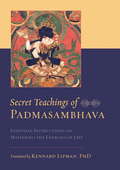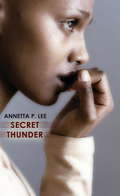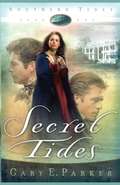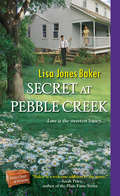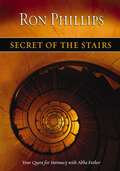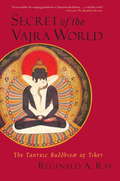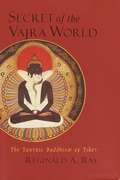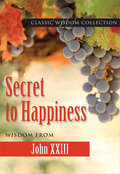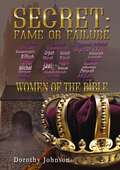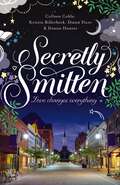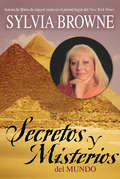- Table View
- List View
Secret Societies: And How They Affect Our Lives Today (Thorndike Basic Ser.)
by Sylvia BrowneFresh from the success of her book Secrets & Mysteries of the World, Sylvia Browne now writes about the clandestine world of secret societies. Sylvia's research, combined with her amazing communication with her spirit guide Francine, has uncovered the fact that many secret societies affect the lives of each of us every day...whether it be in the areas of religion, politics, economy, government, crime, or other worldwide influences. She shares her knowledge of the conspiracies, coverups, long-held secrets, misinformation, and power manipulations of secret societies in both the past and present and how they can affect us today and in the future.From the mysterious secrets of the Knights Templar to the powerful secret societies of the modern age, Sylvia takes us on an amazing journey to explore and unearth the truth. She discusses the amazing influence of the Freemasons on our Founding Fathers, the influence of religion on earth-shaking secrets and terrorism, the agenda of powerful secret societies for a "New World Order," and much more.Sylvia explores it all, and even gives us information on a powerful secret society that no one has even heard about. So lock your windows and doors and read about these societies and their secrets...some will really raise the hair on your neck!
Secret Strength: For Those Who Search
by Joni Eareckson TadaDo you want to know a secret?What's so secret about God? Nothing. And yet everything.Scripture tells us, "the secret things belong to the Lord our God." God has secrets. Some to keep, and some to tell. And who doesn't want to know a secret?Most of us are filled with an incurable urge to discover secrets, to walk the higher and hidden roads. And it is our God, our wonderfully mysterious God, who has placed that yearning within us. He is the treasure we seek...the precious gem to be mined.So take the time to spend these one hundred concise, life-changing appointments with him. And discover incredible handholds of refreshment, courage, and endurance you can cling to in Secret Strength.From the Trade Paperback edition.
Secret Summer Dreams (Holly's Heart #2)
by Beverly LewisHolly's secret dream is to visit her father in California. Andie isn't thrilled with the plan, and neither are Holly's mom and sister. What will summer be like without them, and why does Holly's new friend want her to go so much?
Secret Surrender
by Laura MartinWhat had she let herself in for? Christy King just knew that when she and Drew Michaels met again sparks would fly. So why had she accepted his challenge? Being isolated with this infuriating man might be some women's idea of paradise, but certainly not hers. Had she made a terrible mistake?And then the memories of their night of passion returned to haunt her....
Secret Survivors: Real-Life Stories to Give You Hope for Healing
by Jen Howver Megan HutchinsonEveryone has secrets. Some you might whisper into a friend’s ear, while others may stay locked inside you for years…maybe even forever. It’s those secrets that you tuck away that eventually control you. You may think you’re okay, but really, your secrets can be tearing you apart from the inside out. Secret Survivors tells the compelling, true stories of people who have lived through painful secrets—things that they kept to themselves until they could no longer bear the pain alone. As you read their stories, you’ll be drawn into their journeys towards healing, and you’ll understand why it’s so important to share your secret with someone else in order to start your own healing process. Read the stories of people, who as teens and young adults, dealt with issues like: •Date rape •Physical abuse •Cutting •Pornography addiction •Eating disorders •Incest •Drug and alcohol addiction •Abortion You may find a story that sounds similar to your own secret pain, or you may learn more about secrets that a friend or family member is dealing with. Whether your own story is represented in these pages or not, you’ll feel a connection to the people in these stories, because we all have some kind of pain tucked away. But you don’t have to feel alone in your pain anymore. After you read the stories of these survivors, you’ll find the strength you need to share your own secret and start healing your heart and soul.
Secret Teachings of Padmasambhava: Essential Instructions on Mastering the Energies of Life
by Padmasambhava Kennard LipmanThese Tibetan Buddhist teachings provide instructions for gathering and harnessing basic life energy. According to the tradition, a very effective way to do this is to arouse sexual energy and to direct the essence of that energy toward spiritual realization. According to the philosophy, sexual energy brings one naturally and effortlessly into flow with creativity and awareness in both mind and body--when used skillfully by committed practitioners with appropriate training.These ancient texts, attributed to the great Tibetan meditation master Padmasambhava (who practiced sexual union with the famous Tibetan queen Yeshe Tsogyal), offer traditional Buddhist teachings on the nature of the elements that all beings and our world are made of. They show us a practical view of how to use life-energy for personal development. The teachings are for experienced Buddhist practitioners.
Secret Tides
by Gary E. ParkerTrouble is brewing on the plantation. When the overseer's daughter, Camellia York, accidentally causes the death of the plantation's owner -- who is also the father of the man she plans to marry, Trenton Tessier -- life as she knows it will never be the same. As Trenton begins to pull away from her, Camellia seeks solace from Josh Cain, an older relative with a quiet, but unshakable, faith. But when Cain's own wife dies tragically, the stage is set for Camellia to discover the truth about her family's past -- and her own destiny. Set against the backdrop of the Old South on the eve of the Civil War, Secret Tides is a saga of passion, greed, romance, and faith that you will not soon forget.
Secret at Pebble Creek (Hope Chest of Dreams #4)
by Lisa Jones Baker“Baker is a welcome addition to the genre.” —Sarah Price, bestselling author of The Plain Fame Series Lisa Jones Baker’s heartwarming series continues as a new generation inherits precious hand-carved chests that bring blessings of faith, love, and happiness . . . When Jessica Beachy temporarily moves into the home of her late great uncle, Sam Beachy, she merely plans to remodel, sell, and head back to the city. She’s used to busy St. Louis and can’t imagine how she’ll spend her time in the quiet Amish countryside. But the carpenter she hires, Eli Miller, doesn’t think selling Sam’s home is a good idea. And while he’s steadfast in his Amish faith, he’s instantly drawn to Jessica’s vivacity and unexpected caring—especially as peaceful country ways make her question the dream she thought she wanted . . But a lucrative offer to turn the house into a vacation retreat confronts Jessica with a heartbreaking choice. It will take trust, perseverance—and discovering a hope chest thought forever lost—for Jessica and Eli to boldly face obstacles and embark on a joyous future together . . . “The heart of this romance goes far beyond stereotypes . . . providing an unusual and welcome level of insight into the characters’ inner lives.” —Publishers Weekly on Rebecca’s Bouquet, STARRED REVIEW “A sweet tale. . . . Forgiveness is a key theme, as is the concept that life is a combination of good and bad situations that make us who we are.” —RT Book Reviews on Annie’s Recipe
Secret of the Stairs: Your Quest for Intimacy With Abba Father
by Ron PhillipsWhen people find themselves twisted and floundering in life's turmoil, they long for a safe haven, a place to recover. Dr. Phillips shows that this longing is for a deeper, more satisfying fellowship with the Lord. He demonstrates how we block our understanding of God with spiritual and mental preconceptions and why clearing those obstacles can open our path to a fulfilling and engaging relationship with the Father.
Secret of the Vajra World: The Tantric Buddhism of Tibet
by Reginald A. RayThis book provides an entrée into the Tantric (or Vajrayana) Buddhism of Tibet, as conveyed by Tibetan masters teaching in the West, and as received by their Western students. The Tantric tradition is a unique collection of lesser-known texts, concepts, and meditation practices that are usually made available only to experienced and specially initiated practitioners.The "Vajra World" (vajradhatu in Sanskrit) is a realm of indestructibility, the level of reality beyond all thought and imagination, all impermanence and change, which a fully realized person knows and inhabits. Used metaphorically, "Vajra World" refers to the traditional culture of Tibet and the unique spirituality that is its secret strength.Topics include:The tantric view of human nature and the external worldThe special role of the guru, or tantric mentorThe preliminary practices that prepare the student for full initiationThe major dimensions of Vajrayana practice, including visualizations, liturgies, and inner yogasThe tradition of the tulku, or incarnate lamaThe lore surrounding the death of ordinary people and of saintsThe practice of solitary retreat, the epitome of traditional Tibetan BuddhismSecret of the Vajra World is the companion volume to the author's earlier book, Indestructible Truth: The Living Spirituality of Tibetan Buddhism. While that book focuses on the history, cosmology, philosophy, and practice of the more public, exoteric side of Tibetan Buddhism, this work treats its more hidden and esoteric aspects as they take shape in Vajrayana. Together, the two volumes provide a broad introduction to the major traditions of Tibetan Buddhism.
Secret of the Vajra World: The Tantric Buddhism of Tibet (Volume #2)
by Reginald A. RayVolume 2 of an introduction to Tibetan Buddhism.
Secret to Happiness: Wisdom from John XXIII
by Donna Giaimo FspHow can I discover the secret to happiness and holiness in my life? This collection contains famous and lesser-known writings from the humble 20th century giant, Saint John XXIII. Born Angelo Giuseppe Roncalli and elected pope in 1958, John XXIII was well-loved during his papacy for his humility and gentle wit. Surprising the world with his intention to call Vatican II, he was not a stranger to the worries of life. Secret to Happiness has short chapters, showing us the secret to authentic happiness: humility and confidence in God's will for us.
Secret: 107 Women of the Bible
by Dorothy L. JohnsonAs a health professional, personal conversations with thousands of women from around the world revealed one trend. They had little self-worth, were not empowered and others saw them similarly.It must be noted that even historians portray no ancient writing as unique as the bible, whose successful female characters existed within an exclusively male dominant culture when women were excluded from the population statistic of their times (Exodus. 11:37) and (Matt.14:21 and 15:38).Significant changes are occurring in some areas of the world as women struggle for their rights to freedom and equity. While writing this book, British Broadcasting Cooperation (BBC) highlighted areas of breakthrough, the first story women drivers in Saudi Arabia allowed obtaining driver&’s license. The second story featured a stewardess on a Turkish Airline taking legal action against the Airline for been paid less than her male counterpart. The third Malala Yousafzai (Noble Peace Prize Winner) who was shot in her head by the Taliban 2012 for campaigning for education among girls was fit to return home after six years. The fourth a major historical land mark; her campaign for women&’s right to vote during the 19th Century was memorialized in 2018 more than one hundred years later. In her honor Millicent Farcet the first female statue was erected and unveiled in London.Secret: Fame or Failure provides unbiased, biblical solutions, empowering women by positive role models (although not exclusively for women). It features life in the palace and life among ordinary people who did uncommon things. This unique book enhances the knowledge of men and women who have read and studied the bible for many years creating a hunger for cultural, ancestral heritage within scriptures. It is saturated with revelation and teachings linking the lives of the biblical women to women today.
Secretly Smitten (Smitten #2)
by Colleen CobleSummer, fall, winter, spring--Smitten, Vermont, is the place for love . . . and mystery!There's a secret in Grandma Rose's attic--a forgotten set of dog tags belonging to her first love. But David Hutchins was killed in action and never returned to Smitten. How did the dog tags end up in the attic?The mystery intrigues Rose's three granddaughters--Tess, Clare, and Zoe--and they decide to investigate, though their mother, Anna, warns against meddling. But as the seasons turn and the mystery unravels, the three young women and their mother encounter some intriguing mystery men of their own. Has a sixty-year-old puzzle sparked something new for this close-knit family of women?Join popular romance novelists--and real-life BFFs--Colleen Coble, Kristin Billerbeck, Diann Hunt, and Denise Hunter for four delightful intertwined tales of mystery and sweet intrigue.
Secreto de confesión: Cómo y por qué la Iglesia ocultó el cuerpo de Eva Perón durante 14 años
by Sergio Rubin«En esta obra, Sergio Rubín nos lleva por los vericuetos de un verdadero laberinto de intrigas que jalonaron el peregrinaje del cuerpo sin vida embalsamado de Evita que, a modo de una saga maldita, fue acompañado por el frenesí de violencia política que expandió por la Argentina de aquellos años marcados a sangre y fuego»Nelson Castro El ocultamiento del cadáver de Eva Perón durante más de 14 años fue uno de los secretos mejor guardados de la historia argentina. Todos los argentinos se preguntaban dónde estaba el cuerpo de la “Jefa espiritual de la Nación”. Luego de la devolución a su marido, Juan Domingo Perón, exiliado en Madrid, quedó claro que el Ejército, con la imprescindible colaboración de la iglesia, lo había hecho mediante una formidable operación de inteligencia. Sin embargo, nunca se supo con precisión cómo se planeó y ejecutó el plan. Y, sobre todo, cómo y por qué la Iglesia fue de la partida. Secreto de confesión, escrito por Sergio Rubín, uno de los periodistas más informados sobre la iglesia, es el fruto de una exhaustiva investigación -iniciada por el equipo de periodistas del diario Clarín, integrado por el autor- que le demandó más de cinco años de paciente labor, hasta responder a todos los interrogantes. Basado en testimonios exclusivos y documentos históricos inéditos, Rubín reconstruye minuciosamente los hechos. Y revela que el Papa Pío XII fue informado acerca del plan y no puso obstáculos.
Secretos al alba
by Gabriela ExilartGabriela Exilart vuelve a los escenarios de En la arena de Gijón para contarnos la historia de tres familias atravesadas por las secuelas de la guerra civil española. Con gran destreza y una reconstrucción extraordinaria tanto de los hechos históricos como de la vida cotidiana, nos demuestra en esta novela por qué es una de las escritoras de carrera más prolífica de América Latina. Gijón, España, 1956. María de la Paz Noriega está empeñada en descubrir el secreto sobre el origen de su padre, Bruno Noriega. Lo único que tiene es una vieja nota de los tiempos de la guerra civil. Su afán por la verdad la lleva a la ciudad de Burgos y de allí a los muros de un convento perdido entre las montañas, donde una extraña mujer empieza a desovillar la historia. Un periodista atormentado por su propio pasado decide ayudarla y ambos se sumergen en la época de las batallas, los campos de concentración y las intrigas. Ninguno de los dos sabe que nadie es quien dice ser y que lo que descubrirán los cambiará para siempre. Las guerras producen rupturas abruptas en la vida de las personas modificándolo todo de un día para el otro y sin aviso. Cuando todo termina, el dolor genera silencios profundos que agrietan las distancias y las pérdidas. Los hijos de la guerra, con coraje, se sienten compelidos a reponer la memoria y reparar el alma, tanto por sus padres como por la necesidad de sanar para vivir con plenitud su propio destino.
Secretos ancestrales de manifestación: Trabaja con las Siete Leyes del Universo para manifestar la vida que quieres
by George Lizos• Basándose en la sabiduría ancestral griega y egipcia, explica las Siete Leyes del Universo y cómo identificar qué deseos se alinean con tu propósito superior.• Ofrece un proceso de cinco pasos para manifestar tus deseos y un desafío de manifestación de 10 días para alcanzar una meta específica.• Presenta técnicas de trabajo interno para liberar bloqueos cognitivos y emocionales, así como creencias limitantes que obstaculizan tu viaje de manifestación.¿Quién no querría convertirse en un hábil creador consciente de su propia vida? Al sumergirse en las profundidades de la filosofía hermética y el texto iniciático El Kybalión, George Lizos, experto en manifestación, descubre los intrincados procesos energéticos y las leyes universales que sustentan una manifestación efectiva, siendo la Ley de la Atracción solo un paso en este camino.En Secretos ancestrales de manifestación aprenderás un método revolucionario de cinco pasos para manifestar con éxito tus deseos, alineando tu campo energético con las Siete Leyes del Universo. A medida que integres el trabajo interno en tu proceso de manifestación, descubrirás prácticas energéticas que te ayudarán a liberar y transmutar bloqueos cognitivos y emocionales, así como creencias limitantes que podrían haber obstaculizado tu éxito hasta ahora. Aunque no todos los deseos son susceptibles de manifestarse, este libro te enseñará a discernir cuáles están en armonía con tu propósito superior y con las leyes universales, permitiéndote trabajar en sintonía con ellas.Basada en la sabiduría ancestral y las técnicas milenarias, esta guía práctica ofrece un plan de acción preciso para la manifestación, con ejercicios efectivos y ejemplos inspiradores que ilustran cada paso del proceso. ¡Comienza a manifestar conscientemente hoy con tu desafío personal de 10 días!
Secretos del Mundo Judío
by Bernard Levine Guillermo Alberto Cervantes VindiolaEste libro te abrirá la puerta hacia nuevos descubrimientos emocionantes que nunca has escuchado ni conozcas acerca de la forma de vida de los judíos. Para cualquiera que haya añorado y deseado recorrer la tierra de Israel, para todos aquellos que aman al pueblo judío y añoran saber más acerca de su religión y su forma de vida, para cada cristiano quien ama a Jesús y le gustaría aprender más acerca de sus raíces judías... ¡Este libro único está repleto joyas únicas y especiales!
Secretos del lugar secreto: Llaves para avivar tu tiempo personal con Dios
by Bob SorgeDel autor de En su faz llega otro libro inspirador para alentar y encender su vida devocional. Un libro fue escrito para fortalecer e inspirar nuestra relación secreta con Dios.El lugar secreto es «la matriz de la mañana», el manantial de la verdadera plenitud de frutos del reino. Bob Sorge asegura que sus oraciones son para que cuando usted lea estas páginas reciba un vistazo de la viva relación que Dios se ha propuesto tener con todos.«He escrito este libro con la pasión de poder inspirar y alentar su relación secreta con Dios. Estoy corriendo el riesgo de compartir algunas de las más íntimas y amadas verdades que el Señor me ha dado. Mi oración, mientras usted lee este libro, es que tenga un atisbo de la relación viva que Dios se ha propuesto tener con nosotros. ¡Lo que Jesús tenía con su Padre cuando caminó en esta tierra está disponible para usted!».—Bob SorgeCon este libro como un mapa de ruta, obtenga una visión fresca e inspirada para seguir adelante en un viaje del cual dependen los mismísimos temas de la vida.—Mike BickleEste libro es para volverlo a leer una y otra vez.—Francis Frangipane
Secretos del lugar secreto: Llaves para avivar tu tiempo personal con Dios
by Bob SorgeEl lugar secreto es «la matriz del mañana», la fuente central de la verdadera productividad del reino de Dios. Este libro fue escrito para fortalecer e inspirar nuestra relación secreta con Dios. Bob Sorge asegura que sus oraciones son para que cuando usted lea estas páginas reciba un vistazo de la viva relación que Dios se ha propuesto tener con todos.
Secretos ocultos del mundo judío ahora revelados
by Bernard Levine Gema Pedreda LópezVosotros lo habéis pedido. Por demanda popular, os presento más secretos sobre la vida y costumbres de los judíos. Qué hacen los judíos en sus casas todos los días, qué comen, cómo celebran el Sabbat, de qué tratan los festivos judíos y mucho más. Encontraréis información y una gran satisfacción al descubrir los secretos ocultos del mundo judío.
Secretos para una vida exitosa: Descubre la mujer que Dios quiere que seas
by Karol LaddKarol Ladd es una talentosa maestra de la Biblia y exitosa autora de más de 20 libros, entre los que se incluyen Una mujer con pasión y propósito. Karol es una invitada frecuente en programas de radio y televisión. Su rol más valioso es el de esposa y madre. Disponible en inglés de Harvest House. Bestselling author Karol Ladd shares powerful truths from Colossians and reveals an exciting path to confident living through God's love and grace. With biblical wisdom and an inspiring belief in God's purpose for each woman, Karol helps readers transform the way they see themselves and how they live out their lives as they discover their value and confidence in God. With this vital perspective shift, a woman will: * Transform her thinking through powerful prayers * Cultivate potential by exploring the dreams God gives to her * Step forward with a strong sense of identity in Christ * Deepen relationships and communication with others and with God * Shine with joy and assurance of what she brings to the world Karol's study questions bring dimension to God's leading and hope for women and provide individuals or groups a practical way to explore, know, and live boldly in God-confidence. Karol Ladd is a gifted Bible teacher and a bestselling author. She is a frequent guest on radio and television and regularly posts positive messages and videos on her website, www.KarolLadd.com. Her most valued role is that of wife and mother. Available in English from Harvest House
Secretos sexuales íntimos de los judíos
by Bernard Levine Verónica Fabiano and Cecilia LangoneSecretos sexuales íntimos de los judíos Por Bernard Levine ¿Cuál es la verdad acerca de que los judíos tienen sexo a través de un orificio que se hace en la sábana? ¿Por qué las mujeres tienen que mostrar sus pantaletas al rabino? ¿Qué hacen los rabinos con los prepucios que cortan? ¿Por qué los judíos toman un pollo vivo y lo balancean por sobre sus cabezas? ¿Es cierto que los judíos tienen que escupir a su cónyuge cuando se divorcian? ¿Sabía que el rabino succiona la sangre del pene circuncidado de un bebé? ¿Por qué los judíos entierran los platos en la tierra? ¿Es verdad que los judíos no leen la Biblia? ¿Por qué las relaciones sexuales de los judíos son diferentes? ¿De qué manera los judíos engendran un hijo? ¿Por qué no se les permite cantar a las mujeres delante de los hombres? ¿A qué hora del día puede una mujer casada tener sexo con su marido? ¿Por qué no se les permite a las mujeres judías mostrar los codos o las rodillas a los hombres? ¿Cómo hacen los judíos para concertar una cita y conocer a alguien del sexo opuesto? ¿Es verdad que las mujeres judías no pueden estrecharse la mano con los hombres? ¿Por qué los judíos ortodoxos arrojan piedras a las mujeres que caminan por las calles de Jerusalén? ¿Sabía usted que la mayoría de los judíos no entienden lo que rezan? ¿Cuál es el número de la suerte de los judíos? ¿Sabía usted que a los judíos se les da una lista de las marcas de alimentos que se les está permitido comprar? ¿Por qué los niños judíos no se cortan el cabello que crece en las sienes? ¿Escuchó alguna vez que los judíos tienen que comprar sus asientos en la sinagoga para las Altas Fiestas Judías? Este volumen es una edición totalmente renovada con información confidencial nunca antes publicada.<br/
Secretos y Misterios del Mundo
by Sylvia BrowneFor those of us who have always been fascinated by the unexplained—or inadequately explained—secrets and mysteries of this world, Sylvia Browne now brings her great insight. Using a combination of information from her spirit guide Francine as well as her own incredible psychic powers, Sylvia augments current scientific research to provide us with detailed explanations about seeming inexplicable concepts. From the Great Pyramid to Stonehenge, Sylvia reveals amazing facts about some of the world’s most mysterious sites. The truth behind sacred and controversial objects such as the Shroud of Turin and the Holy Grail are brought to light; and fascinating and mystifying topics such as crop circles, the Lost Continent of Atlantis, UFOs, Easter Island, and much more are examined and clarified. Sylvia tears away the obscure and timeworn explanations that hide the underlying truths about these fascinating subjects.
